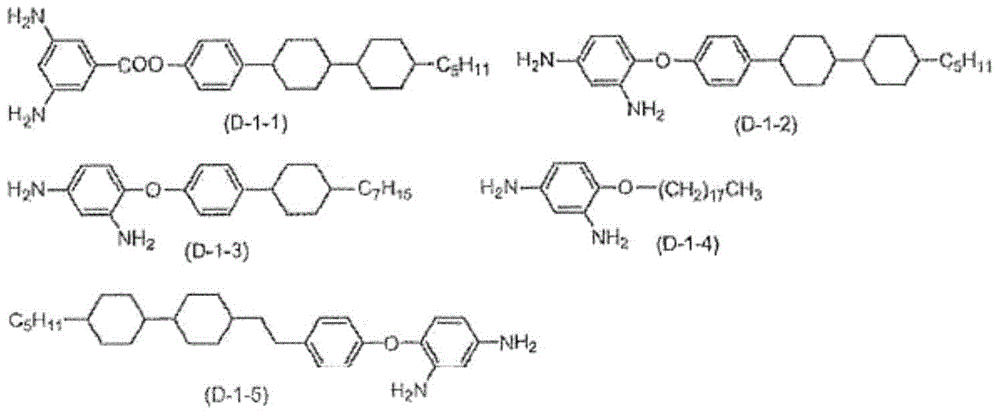Liquid crystal aligning agent, liquid crystal aligning film and liquid crystal display element
A technology of liquid crystal aligning agent and liquid crystal aligning film, applied in the directions of liquid crystal materials, instruments, optics, etc., can solve the problems of unknown materials, and achieve the effect of excellent long-term reliability and less degradation of display quality
- Summary
- Abstract
- Description
- Claims
- Application Information
AI Technical Summary
Problems solved by technology
Method used
Image
Examples
Embodiment
[0178] Hereinafter, although an Example demonstrates this invention more concretely, this invention is not limited to these Examples.
[0179] The imidation rate of the imidation polymer of the polyamic acid in the synthesis example described below was measured as follows.
[0180] [Imidation rate of imidized polymer]
[0181] The imidized polymer solution obtained in each synthesis example was poured into pure water, and the obtained precipitate was fully dried under reduced pressure at room temperature, dissolved in deuterated dimethyl sulfoxide, and tetramethylsilane was used as Standard substance, measured at room temperature 1 H-nuclear magnetic resonance (Nuclear Magnetic Resonance, NMR). according to income 1 In the H-NMR spectrum, the imidization rate [%] was obtained from the following formula (1).
[0182] Imidization rate[%]=(1-A 1 / A 2 ×α)×100 (1)
[0183] (In formula (1), A 1 is the peak area of protons derived from NH groups that appear near the chemica...
Synthetic example 1
[0185] Synthesis Example 1 (Synthesis of Polyamic Acid)
[0186] 196 g of 1,2,3,4-cyclobutanetetracarboxylic dianhydride as tetracarboxylic dianhydride and 200 g of 4,4-oxydiphenylamine as diamine were dissolved in N-methyl-2-pyrrolidone ( NMP) 2,244 g, reacted at room temperature for 6 hours. Then, the reaction mixture was poured into a large excess of methanol to precipitate the reaction product. After the recovered deposit was washed with methanol, it was dried at 40° C. for 15 hours under reduced pressure to obtain 336 g of polyamic acid (PA-1).
Synthetic example 2
[0187] Synthesis Example 2 (Synthesis of imidized polymer of polyamic acid)
[0188] 224 g of 2,3,5-tricarboxycyclopentylacetic dianhydride as tetracarboxylic dianhydride and 108 g of p-phenylenediamine as diamine were dissolved in 2,988 g of NMP, and reacted at 60° C. for 4 hours to obtain Polyamic acid solution. Then, 320 g of NMP3 was added to the obtained polyamic-acid solution, and 395 g of pyridine and 305 g of acetic anhydride were added, and dehydration ring-closure reaction was performed at 110 degreeC for 4 hours. After the dehydration ring closure reaction, the solvent in the system was replaced with fresh NMP to obtain a solution containing 15% by weight of the imidized polymer (PI-1) having an imidization rate of 88%.
PUM
| Property | Measurement | Unit |
|---|---|---|
| viscosity | aaaaa | aaaaa |
| viscosity | aaaaa | aaaaa |
Abstract
Description
Claims
Application Information
 Login to View More
Login to View More - R&D
- Intellectual Property
- Life Sciences
- Materials
- Tech Scout
- Unparalleled Data Quality
- Higher Quality Content
- 60% Fewer Hallucinations
Browse by: Latest US Patents, China's latest patents, Technical Efficacy Thesaurus, Application Domain, Technology Topic, Popular Technical Reports.
© 2025 PatSnap. All rights reserved.Legal|Privacy policy|Modern Slavery Act Transparency Statement|Sitemap|About US| Contact US: help@patsnap.com



